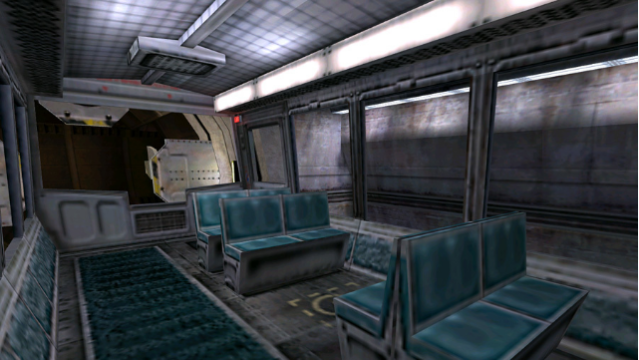Last night, we started a playthrough of Half-Life on Kotaku‘s Twitch channel. Punchy shotguns and nasty aliens make for a fantastic shooter experience, but the game begins less dramatically, with a long train ride. It’s one of the most memorable openings in gaming history, but it’s the least Half-Life thing about Half-Life.
When Half-Life released in 1998, it redefined shooters with its strong gunplay and seamless story presentation. Players moved from action sequences to without pause, killing soldiers and chatting with friendly scientists. The Black Mesa Research Facility is a twisting maze of jumping puzzles and gunfight arenas. And yet the game starts remarkably slow, isolating players in a claustrophobic train car for more than five minutes.
This opening chapter, “Black Mesa Inbound,” is a paradoxical study in indulgence and restraint. Inhabiting the body of everyday research assistant Gordan Freeman on his morning commute grounds players in the space of Black Mesa. Players see the facility at the height of power, a whirling scientific wonderland packed with robots, toxic waste, and massive tesla coils. The PA system drones on about safety procedures and staff decathlons.
This sequence is monotonously long by modern standards. But its indulgence is not found in the slow pacing or near-fetishisation of the facility’s military hardware. Rather, it is found in the game’s literal construction. Half-Life was build on the GoldSrc engine, a highly modified version of the Quake engine that put an emphasis on creating detailed spaces occupied by NPCs with robust artificial intelligence.
The Quake engine built playgrounds; GoldSrc built worlds. Viewed in this light, “Black Mesa Inbound” is a surprising piece of self-congratulatory spatial design. It wants to impress the player. Each new room exists to be observed much the same way tourists marvel at the sights while riding the monorail into Disney World. Unfortunately, Black Mesa is not nearly as interesting to observe as to explore.
“Black Mesa Inbound”‘s entire design ethos stands in stark contrast to the rest of the game. Half-Life‘s movement speed follows in the quick and slippery Quake tradition. The enclosed tram gives little space for players to familiarise themselves with controls, a task relegated to an optional training tutorial separate from the main game.
The largest space in the train is a small indentation where handicapped seating opens up the floor. Half-Life‘s first impression is tight, limited, and joyless, nothing like the rest of the game. This opening stands apart from modern games like 2016’s Doom and Titanfall 2, which throw players straight into the action, teaching them the game’s controls all the while. But it also gives a close look at Gordon Freeman’s boring life before the action kicks off.
Half-Life‘s DNA permeates games to this days, from Titanfall 2‘s intricate levels to Wolfenstein: The New Order‘s roaring sound design. Half-Life‘s legacy rest largely in how it redefined action, but its most iconic scene is the least action-packed.

Comments
8 responses to “Revisiting The Intro Scene Of Half-Life”
I still think it’s amazing.
Indulgent? Sure. Slow? Sure. Memorable? Absolutely.
It sets the tone perfectly and I wouldn’t have it begin any other way.
Well, that’s kind of the point, and it was something totally new back in 1998. It was establishing that this was starting out as any other normal day for normal scientist Gordon Freeman – the buildup to the event that drives the rest of the storyline. And it did that particularly well.
its an entire build up to the point “we are waiting for you Gordon… in the TEST chamber”
So how about that Half-Life 3 thing, huh?
Not happening and I’m more surprised some still think it will.
Too much time has passed and the writer has retired.
Given the amount of time that has passed, I think it better that Half-Life be left as it is.
That’s for sure. Here is a conversation that actually happened when I had two in a room.
Scientist #1: “Can I ask you something?”
Scientist #2: “Yes?”
Scientist #1: “Do you know who ate all the doughnuts?”
Pretty lame I know but back then I though it hilarious.
Has anyone else here heard odd conversation between the NPCs?
Unless I’m mistaken that was one of the gags about the game’s AI. If one left the NPCs alone, they got bored with the player and start having their own conversations.
The original Max Payne had some interesting ones. One of my favourites was two guys clearly talking about the Matrix movie and the slow motion gunplay.
This article is like reviewing a CGI heavy film from the 90s and saying the CGI looks bad, rather than dated. Gotta love that context free garbage from the US team.